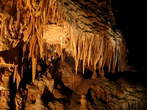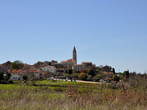Porec and its surroundings are known for many natural and cultural attractions that attract numerous domestic and foreign visitors. Among the most notable places are the town of Porec, Sveti Lovrec, Visnjan, Vrsar, and the picturesque Baredine Cave.
Porec is a popular tourist destination located on the western coast of Istria. The Porec Riviera stretches from the Lim Channel in the south to the valley of the Mirna River in the north. Famous tourist resorts include Zelena Laguna, Bijela Uvala, Plava Laguna, Brulo, Spadici, Materada, Ulika, Cervar-Porat, and Lanterna. The town boasts a well-preserved old town center. The most prominent landmarks include the Northern Tower by the Peskera Bay, the Pentagonal Tower at the entrance to Decumanus Street, and the Round Tower offering a view of the waterfront. Within the former city walls lies the famous complex of the Euphrasian Basilica, the Romanesque House, the House of Two Lighthouses, and the oldest square, Marafor, where remnants of ancient life can be found nearby.
Sveti Lovrec is a settlement located in the western part of Istria, approximately 14 km from Porec. The town was named after the cemetery church of St. Lawrence from the 8th century. The local population has traditionally been engaged in agriculture, while some also work in business and service industries. Today, Sveti Lovrec has an urban appearance with well-preserved Venetian walls and city gates, which were reinforced and restored in 1368. The three-apsed Church of St. Martin dates back to the 9th or 11th century. In 1838, it received a new facade, while the frescoes originate from the 11th and 15th centuries. The wooden altar from the 16th century is the work of a local master. The town loggia with a lapidary from the 15th century stands next to the church, while across the main square stands the pillory. The medieval walls are well-preserved, with the oldest parts dating back to the 10th and 11th centuries.
Visnjan is a small Istrian settlement in Croatia and the administrative center of the municipality of the same name, which falls under the Istria County. This is the westernmost county of Croatia, covering a large portion of the Istrian Peninsula. The official center of the county is Pazin, located in the geographical heart of the peninsula. The municipality of Visnjan extends between the Lim Channel in the south and the Mirna River in the north, just about 15 kilometers from Porec. Visnjan is situated on top of a hill and is surrounded by fields, meadows, and forests of white hornbeam and oak. The name Visnjan originates from the Latin word Vicinianus, meaning nearby. The first written mention of Visnjan dates back to the 11th century. Until the 18th century, the settlement was surrounded by walls built during the rule of the Venetian Republic. Visnjan has a picturesque old town center. The most notable landmarks include the Church of St. Anthony, the sundial, the bell tower, the Sincic Palace, the town loggia, the Church of St. Cyricus and Julitta, the town gate, the well, and the Church of St. Rocco. Visnjan is best known nationally and internationally for its observatory, famous for the discovery of many asteroids. The observatory is located on the nearby Tican Hill and is surrounded by a beautifully landscaped park and forest.
Vrsar is a picturesque town located only about ten kilometers from Porec. It is recognized as a typical Istrian castle settlement. The inhabitants once engaged in viticulture and fishing, while today tourism is the dominant industry. The sea in front of Vrsar is dotted with numerous small islands, adding to the scenic beauty of the area. On the surrounding hills, ancient Illyrian hill forts were once located, a distinctive feature of the Istrian landscape, especially around the hinterland of the Lim Bay. Traces of the Roman settlement Ursaria can still be found in the harbor and nearby surroundings, including villas and an ancient aqueduct. The ancient settlement extended along the coast, while nearby prehistoric quarries and urn graves have also been discovered. In later periods, the settlement was moved to the hill and fortified. From medieval Vrsar, only the western city gate and parts of the fortress remain. The most significant cultural monument is the Romanesque Church of St. Mary, built in the 12th century near the foundations of an earlier early Christian church. The town's development was greatly accelerated by tourism. Along the coast, near the harbor, there is a campsite and a hotel complex set in a pine forest. The lush vegetation and coastline, which gently descends into the sea with flat rocks and beaches, make it an ideal spot for swimming. On the nearby island of Koversada, there is a famous tourist campsite that attracts many domestic and international visitors.
The Baredine Cave is located near the village of Nova Vas, between Tar, Visnjan, and Porec. The road leading to the cave is well-marked with signposts, and there is a large, well-organized parking area in front of the entrance. The Baredine Cave is a protected geomorphological natural monument. Over centuries, stunning underground sculptures—stalactites and stalagmites—have formed inside the cave.
The Baredine Cave complex includes several facilities: an information point with ticket sales, souvenirs, postcards, and other items; a covered terrace with a diverse gastronomic offer; a gallery featuring a photography exhibition; an ethnographic collection of old agricultural machinery; the Speleolit caving center; and a picnic area with benches and tables available for nature lovers looking to enjoy a meal in the beautiful surroundings.







 from 99 €
from 99 €
 from 108 €
from 108 €